Role of Wrist Action in Putting: Unlocking Secrets for Better Strokes
Have you ever heard the highly popular golf tip, “keep the wrists out of it when putting?”
I’ll have to admit; the advice isn’t all that bad; excess wrist motion in putting is, without a doubt, a problem. However, there is no way to leave the wrists out of your putting stroke. Your wrists are going to move.
You can learn to move your wrists correctly and become a more consistent putter because of it. With over 1,000,000 swings and putting strokes analyzed, we have learned what the best players do in their putting strokes and how you can become a better player by improving your wrist action in putting.
Wrist Action in Putting – Key Takeaways
- Wrist motion in the putting stroke will impact the face and the putter’s path.
- More important than finding the perfect angle of your wrist position is to ensure that you are consistent and following patterns.
- Many golfers try to decrease or eliminate wrist motion in the putting stroke, but this is not necessarily the best method; the wrists will move. Learning the best ways to move both the lead and trail wrist is important.
- HackMotion can be used to establish a baseline for your putting stroke and then to check on consistency and stability at impact.
How do the Wrists Move in the Putting Stroke?
The wrists have three ways in which they move in a golf swing; rotation, radial/ulnar deviation, and flexion/extension. Those same wrist movements apply to the putting stroke. Putter face and putter stroke are both impacted by how the wrists move.
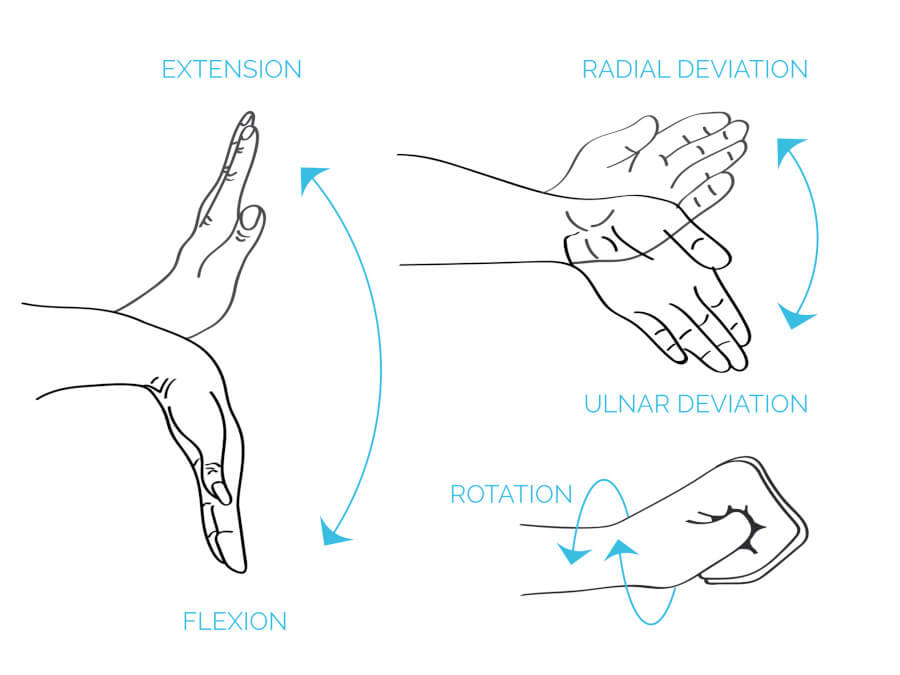
Extension and Flexion
For most amateur golfers, the easiest place to start is the extension and flexion. Extension and flexion feel like the bending up and down of your wrist, where your palm points down towards the ground or up towards the sky.
In putting, we focus on both the lead wrist and the trail wrist movement. As a golfer, you may have an easier time focusing on the trail than lead, so it’s important to understand them both.
- Lead wrist extension (cupping) adds loft to the putter face, increasing the launch angle.
- Lead wrist flexion (bowing) removes loft of the putter face, decreasing the launch angle.

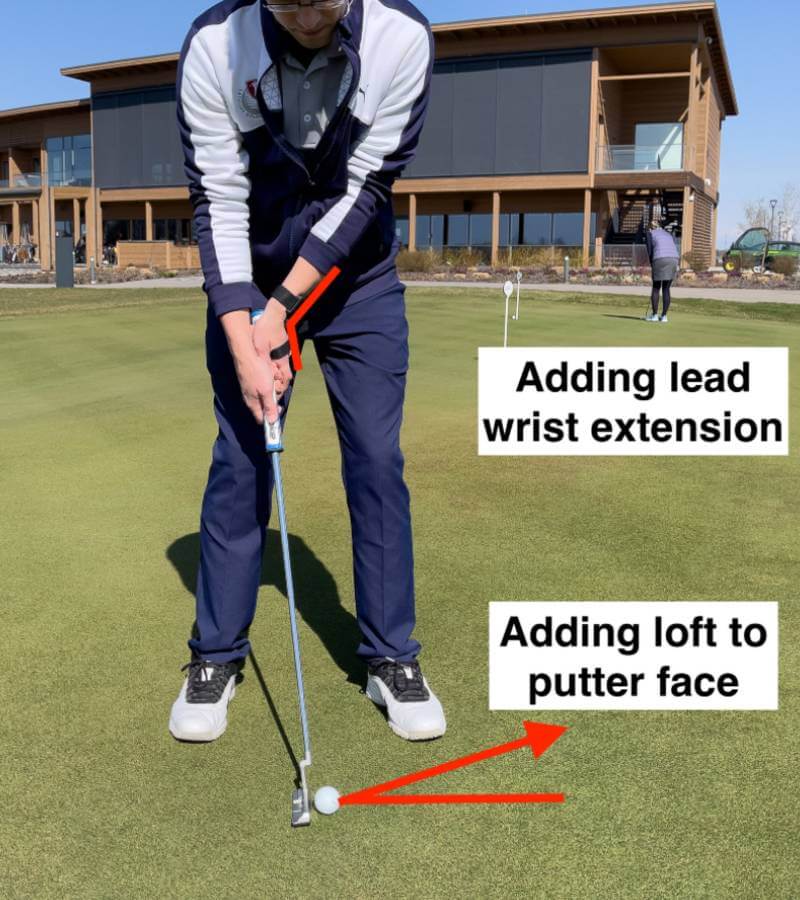
As you can see from these images, when you cup your lead wrist, it has an immediate impact on the launch angle of your putt. With a launch angle that is anything other than standard, your putt could end up short or long of the hole, and it may not experience as smooth of a roll on the green.
- Trail wrist flexion (bowing) adds loft to the putter face, increasing the launch angle.
- Trail wrist extension (cupping) removes loft of the putter face, decreasing the launch angle.
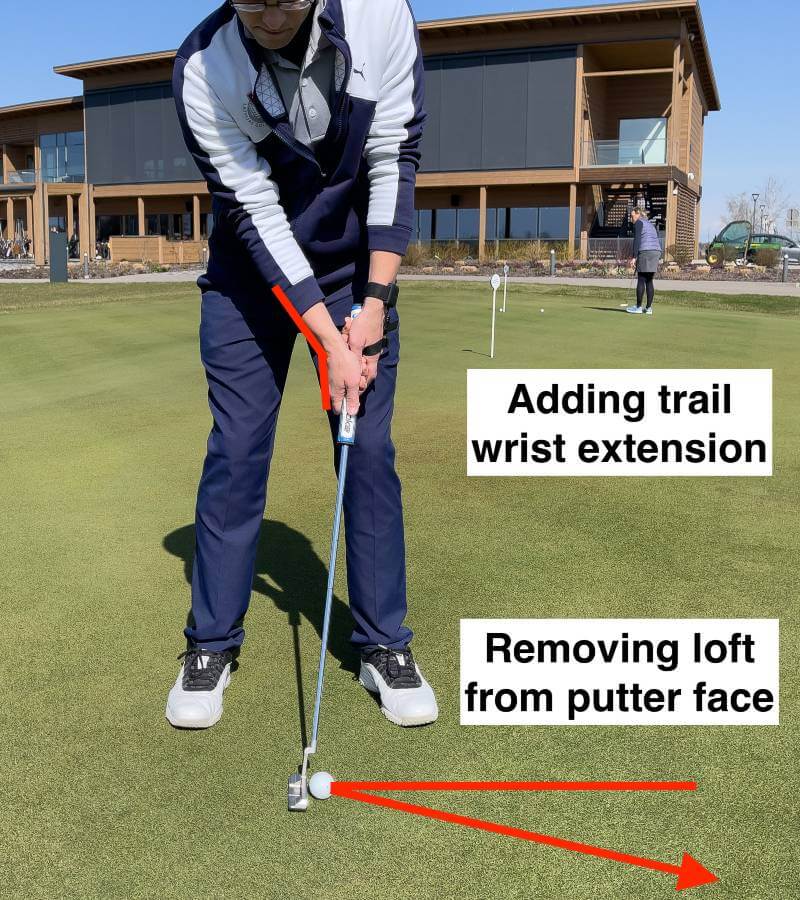
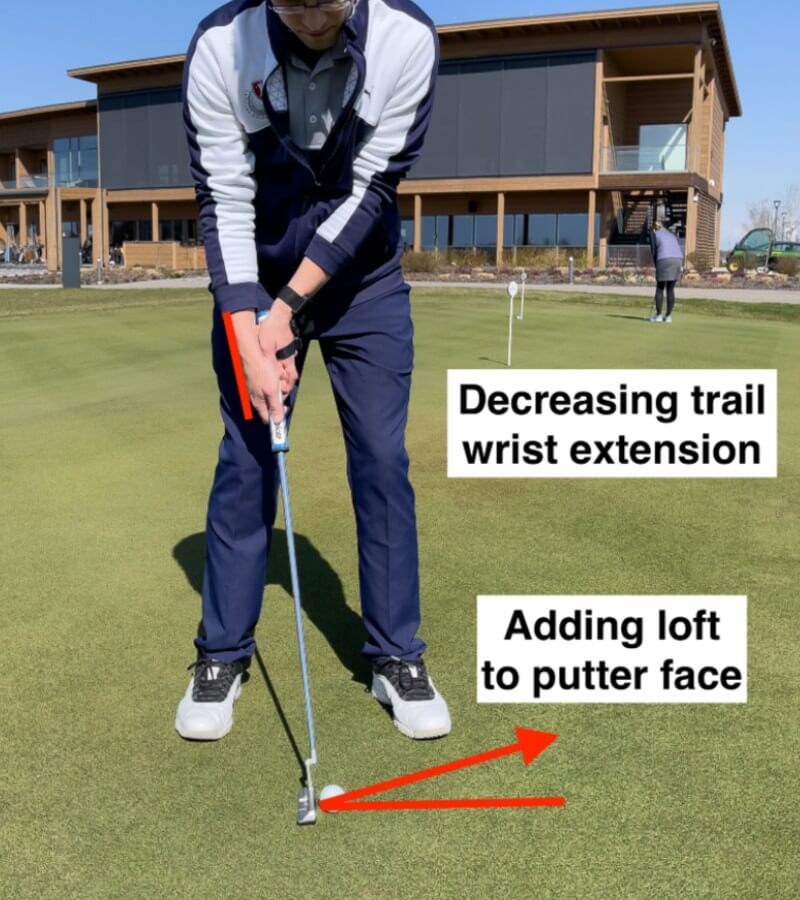
The trail wrist has the opposite effect on the golf putter face that the lead wrist has. When you change the wrist angle in one of your wrists, you will change it in the other (if using a standard putting grip).
The goal is to get the wrists into a more neutral or stable position without excess bowing or cupping of either wrist.
Radial Deviation
Have you ever seen golfers that get the putter way off the ground on their backswing? It’s not necessarily that their path is entirely off, but instead that when the putter swings back, it moves off the ground.
- Radial deviation moves the putter face above the initial shaft plane.
- Ulnar deviation moves the putter face below the initial shaft plane.
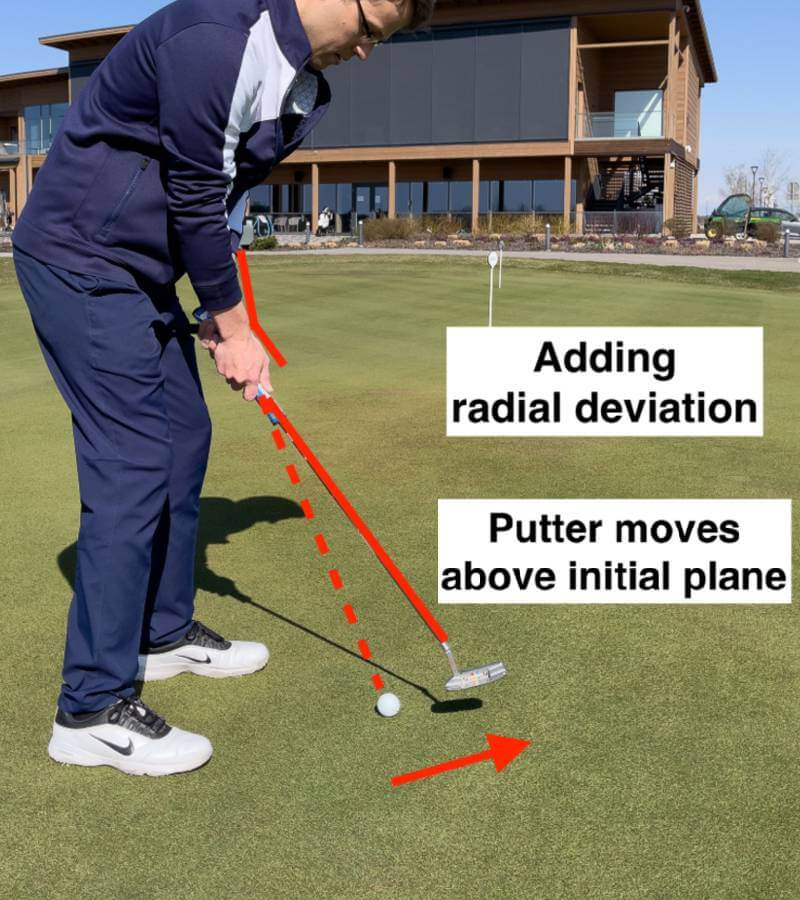

Too much radial deviation can encourage you to lift the putter and strike it on the downswing. The problem is a golf ball that jumps at impact, never getting started on the proper path.
Ulnar deviation is a problem that many players make when trying to develop and perfect a more arc-style putting stroke. The golfer misunderstands that slight arc to the inside with an increase in ulnar deviation and causes the putter to make an inconsistent impact with the golf ball.
Rotation
If you are a golfer that tends to push or pull the ball with the putter, then rotation is probably playing into your issues.
- Rotation in a Clockwise direction (palm up move) twists the putter face open. The ball will go off-target to the right, a push.
- Rotation in a Counter-Clockwise direction (palm down move) twists the putter face closed. The ball will go off-target to the left, a pull.
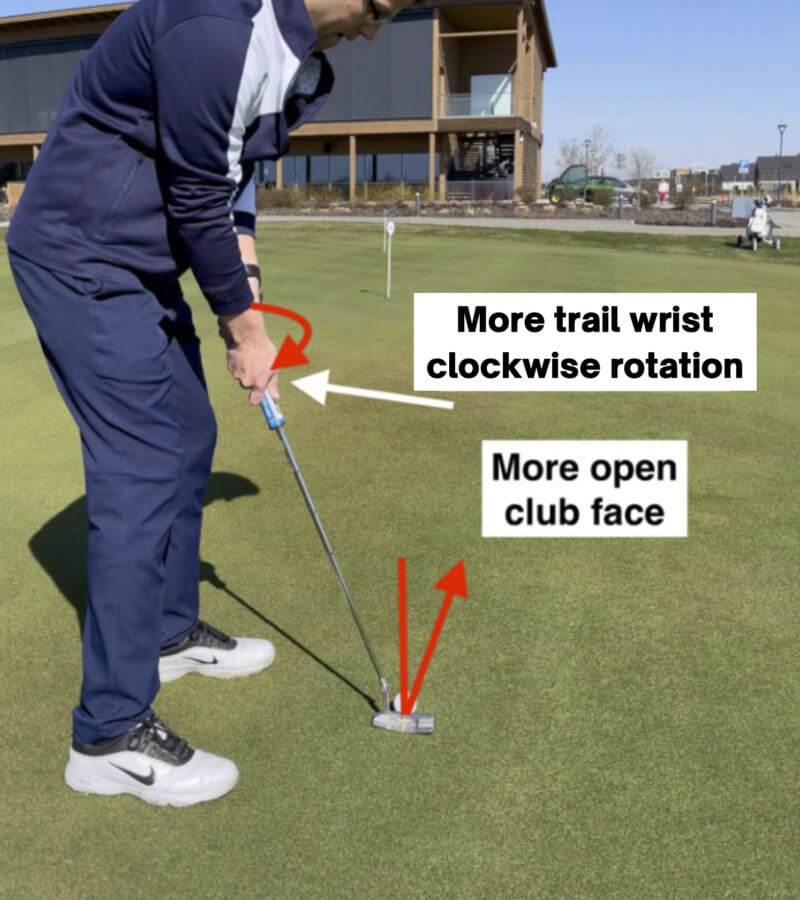

As you can see, rotation of the wrists in putting has a tremendous impact on the putter face and the angle of the putter face when you stroke the golf ball.
Twisting the hands too much or at the wrong time only further increases your issues with rotation in putting and overall consistency.
Common Mistakes Golfers Make with Wrists in Putting
When identifying common mistakes that golfers make with their wrists in putting, it is often helpful to look at what professional golfers do in their putting strokes.
The professionals are obviously the most consistent putters, and when you break down how the putting stroke works, consistency becomes the most important feature.
Amateur golfers tend to focus too much on having perfectly still wrists. In doing so, they end up creating motions and movements that are not accurate, all while trying to keep the wrists entirely still.
Remember, this is not possible. Tour players have wrist rotation, and they even have some fluctuations in wrist movement throughout their stroke.
Another area where amateur golfers tend to fall behind the professionals a bit is when it comes to wrist rotation. Many amateur players, in an effort to keep the putter back on a straight path, will end up restricting rotation.
With natural movements in the human body, your putter will rotate on the backswing, even if you have more of a straight back and straight-through stroke. Look at it this way, all putting strokes are arc style; some just have a larger arc than others.
Professional golfers rotate the putter face open to the target on the backswing and then rotate the opposite direction of the downswing to help close the face. The most important thing to notice here is the consistency in the amount of rotation.
When you can create a reliable and consistent amount of opening and closing of the clubface, you can repeat the stroke and then fill in with all the other important aspects of putting (like speed, distance control, alignment, and learning to read the greens).
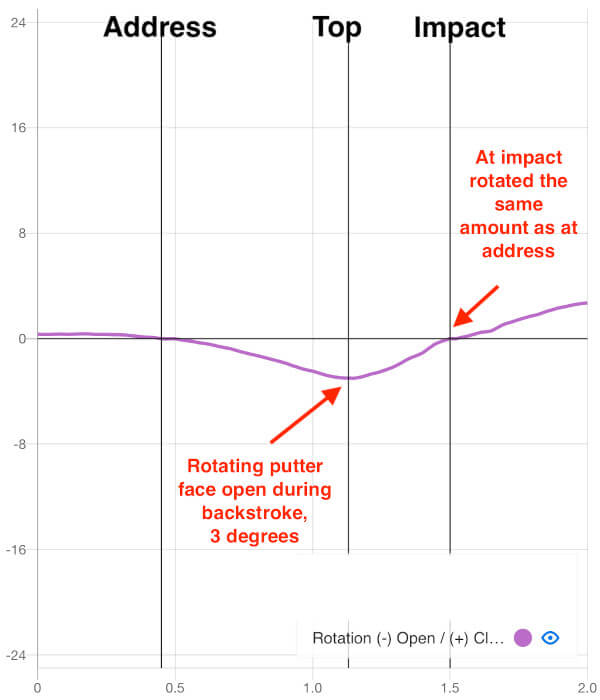
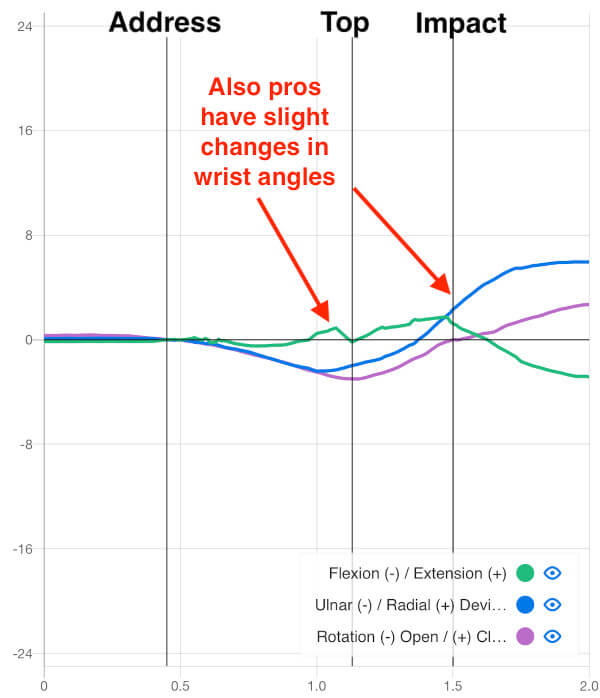
How to Improve and Correct Wrist Action in Putting
To improve your wrist action in putting, there are a few key steps to follow. You know the way you like to practice and improve, and you can implement that into these guidelines.
1. Take Video and Collect Data
Combining a video of your putting stroke with the HackMotion data can be very powerful. The video gives you the visual feedback you need to recognize issues in the stroke. The HackMotion records wrist data at set up, during the backswing, and then again at impact.
Take about 10 to 15 putts with your HackMotion sensor on your lead wrist and look at your collected data.
Pro Tip:
Do this from about 10 feet away from the hole; when you have mastered this distance, repeat the entire process from 20 or even 30 feet away and see what changes/mistakes you are making to your stroke when you get further from the hole.
2. Look for Consistency
The first thing to do is look for consistency. Do you have consistency in any of your wrist motions during the backswing or at impact?
Those consistent strokes are the ones that we want to keep around. Even if that stroke needs tweaking, it’s a good idea to capitalize on consistency.
3. Check for Too Much Extension
Ensure that you are not adding an extension on the backstroke and then increasing the extension again as you go after the ball. Again, this is a pattern that is often seen with golfers trying to hold the clubface on a path that it doesn’t need to be held on.
Professional players have very little increase in extension on the backstroke and certainly don’t have it on the downstroke.
4. Rotation Patterns are Important
Rotating the putter face slightly open and then rotating it back to closed helps you keep the putter head on the proper line. Pay close attention to these rotation patterns if you want to be a consistent player.
Seeing that you rotate on the backstroke but then you don’t rotate well through impact could be a reason why you are leaving your putts out to the right.
5. Follow Up with HackMotion using Wrist Stability Mode
Now that you have properly analyzed your golf putting stroke and you want to make some changes, you can use the HackMotion wrist stability mode for further practice and development.
For wrist stability mode:
- Record your data by taking 10 putts in a row and see if your misses are right or left of the cup.
- Take a look at the direction you are moving your putter face to cause the push or the pull.
- Choose a suggested range within the HackMotion Wrist Stability mode that could help bring your putter closer to being on the right track.
- Regardless of how you grip the club and set up, the range is what matters, and the change from address position to top of backstroke to impact is all that is measured.
FAQs
Here are a few of the most commonly asked questions about the role of wrist action in putting.
Wrist action can feel a little complicated, mostly because you have been taught to keep the wrists out of the putting stroke. Wrists are very involved in putting; it’s just a matter of knowing how to use them.
Do you use your wrists in putting?
Wrists are used in putting to rotate the putter face open and then back to square at impact. Without the wrists, we could not keep the putter on a great path and create a consistent golf putting stroke.
How do I keep my wrist firm when putting?
One of the best ways to keep your wrist firm when putting is to use HackMotion.
HackMotion will give you a real-time look at the movement your wrist is making and whether or not you are extending it at the wrong times.
With the HackMotion device, you can not only see what you are doing wrong in your putting stroke but feel it at the same time.
Should you break your wrist when putting?
Breaking the wrists when putting is likely going to cause issues with the amount of extension and flexion that you have in your putting stroke.
Instead of focusing on breaking or not breaking the wrists, instead, create a better path and allow the putter face to rotate more naturally.
How do you putt without breaking your wrist?
If your wrists feel as though they have too much movement during your putting stroke, use the HackMotion wrist sensor to record your data and then learn to repeat it.
Putting without breaking your wrists is possible, but putting without any wrist motion is not realistic.
What is the best hand position for putting?
There is no perfect putting grip. All putting grips that allow you to consistently repeat your stroke are good. The best hand position for putting helps you square the putter face up as it comes closer to the golf ball.
Final Thoughts
Hopefully, this guide helped to clear up some of your misconceptions about the role of wrist action in putting.
It’s important to let go of the idea that wrist action is non-existent in putting. All golfers move their wrists; they just have to learn how to do it effectively and consistently.
The biggest difference between the amateur and the professional player is the consistency in the movement of the wrists. If you can’t repeat a motion, it’s going to be very difficult to eliminate those three putts!